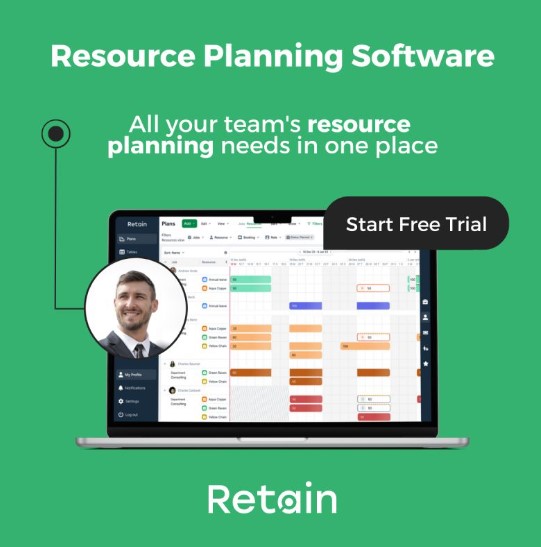Managing resources with spreadsheets and disconnected systems isn't going to cut it anymore. If you've ever thought, "There’s got to be a better way," you're not alone—and you're right. Enter resource planning software, your soon-to-be secret weapon for turning chaos into cohesion.
This article is your blueprint for convincing the business that it's time to invest in a tool that makes resource planning a breeze. The tips in each section will help make your case and transform resource planning into a streamlined operation.
So let’s get to the good part.
The importance of resource planning
Those in resource planning are piecing together people, budgets, and projects, to create business success. It's no small feat, especially when the Project Management Institute tells us that nearly 10% of every pound spent on projects can go down the drain due to poor resource planning. That's not pocket change; that's a direct hit to your bottom line.
?But here's the bright side: effective resource planning can be a game-changer. It's not just about making life easier—although it certainly does that—it's about optimising your entire operation. By allocating resources more efficiently, you boost productivity and even profitability. In plain terms, it means getting more bang for your buck.
?See also: How resource planning can support and improve workplace wellbeing
Identifying the problem
Many businesses struggle with resource planning, often without even realising it. The symptoms may vary—overworked staff, projects always running late, or budgets that somehow seem more like a wish list than an actual plan. The underlying issue? Lack of effective resource management.
First things first, you need to take a hard look at your Key Performance Indicators (KPIs) to pinpoint where things are going awry. Are projects consistently overshooting their deadlines? Is employee turnover higher than you'd like? If this sound familiar, it's time to consider a more robust approach to resource planning. Don't just rely on gut feelings; dig into the metrics and make a case that's hard to ignore.
The good news? Once you identify the bottlenecks, the path forward becomes clearer. Whether it's a mismatch of skills and tasks, or poor visibility into project statuses, acknowledging the problems is the first step to solving them. In short, knowing the 'why' will help you make a bulletproof case for the 'what'—in this case, resource planning software.
Research & selection: choosing the right resource planning software
After you've pinpointed the hiccups in your resource planning, it’s time to weigh-up your options. There's a lot to consider, from features and scalability to how user-friendly the platform is. And it's not just about solving today's problems, but also about future-proofing your operations.
First off, let's talk about features. Are you more focused on staff allocation, budget forecasting, or perhaps project timeline estimations? Different platforms excel in different areas, so make sure the software aligns with your key pain points. Don't go for overkill; the bells and whistles are nice, but focus on the must-haves for your organisation.
Cost is undoubtedly a significant factor, but don't forget to assess the potential return on investment (ROI). Cheap now could mean expensive later if you end up with a system that can't grow with you. It's not just about the upfront investment; take into account training, possible software integrations, and how much time you'll save when your resources are managed efficiently. In the long run, the right software isn't a cost—it's an investment in smoother, more efficient operations.
?See also: How to choose the best resource management software (9 must-haves)
Stakeholder analysis
Once you’re sold on the idea of resource planning software, unless you're the sole decision-maker, you've got some convincing to do. In this case, stakeholder buy-in is crucial, and the trick is to speak their language. Whether it's the CFO concerned about costs, project managers wanting more control, or team members looking for work-life balance, each stakeholder has a unique set of priorities.
First, identify who the key stakeholders are. Typically, this will include senior leadership, finance teams, project managers, and employees who'll be using the software daily. Once you've got your list, consider what each stakeholder stands to gain—or lose—from implementing the software.
Now, time to craft your message. For finance, it's all about the numbers—ROI, cost-savings, and bottom-line benefits (more on this next). Project managers will likely be keen on efficiency and control over timelines and resources. And they’re looking for a tool that makes their lives easier, not more complicated. By tailoring your pitch to address the concerns and needs of each stakeholder, you're not just making a case for software; you're making a case for a better, more efficient way of doing business.
Cost-benefit analysis
After you've pinpointed the problems and identified the stakeholders, now comes the number-crunching part—working out whether the investment is worth it. While the term 'cost-benefit analysis' might sound daunting, we have a free tool to make this really easy to calculate.
Use our simple calculator to find out the ROI Retain could deliver for your business based on your current utilisation, sourcing costs and revenue. Simply enter the relevant information to see how much you could save.
Once you can see if the numbers stack up, this is the clincher—the hard data that will make your business case difficult to ignore.
?See also: How resource planning impacts ROI
Building the business case
Now let’s pull all this together. After you've done all the groundwork, it's time to compile your findings and insights into a compelling business case.
?You can steal our free business case template here. Simply edit the slides with your own business information.
Here's a breakdown of the key elements your case should include:
1. Executive summary
Provide a high-level overview that summarises the key points of the business case. Think of this as the 'elevator pitch' that captures the essence of why the resource planning software is a necessity, not just a nice-to-have.
2. Current situation analysis
Expand on the problem areas and bottlenecks you've previously identified. Paint a clear picture of the existing issues, backing it up with data and metrics where possible. This forms the baseline against which improvements can be measured.
3. Solution overview
Introduce your chosen resource planning software as the solution to the problems you've outlined. Discuss its features and how they align with the specific needs and gaps in your current operations.
4. Financial analysis
This is where your cost-benefit analysis and ROI calculation comes in. Present the total ROI alongside the projected benefits.
Psst. If you haven’t already, make sure to take two minutes to find out your company ROI in our handy tool here.
5. Risk assessment
Every investment carries some degree of risk. So identify any potential risks that come with implementing the new software—like downtime during transition or resistance to change—and propose mitigation strategies for each.
6. Implementation timeline
Finally, map out a realistic timeline for rolling out the resource planning software, including key milestones like vendor selection, software customisation, training, and full-scale deployment. Make sure to include a contingency plan for unexpected delays or issues.
?This comprehensive business case should arm you with all the information and insights you need to win stakeholder buy-in. Each of these components is essential for a robust, compelling case that can stand up to scrutiny and help pave the way for implementing your chosen resource planning software.
Getting support and buy-in
At this stage, you're armed with data, insights, and a solid business case. The final hurdle? Winning hearts and minds within your organisation. Start with the data but go beyond it. Share stories or examples that illustrate the everyday pain points your team faces due to insufficient resource planning. Make it relatable. If people can see themselves in the narrative, they're more likely to support the change.
Don't underestimate the power of a pilot programme. Demonstrating a 'quick win' can build momentum and encourage wider support. Choose a project or department where the software's impact will be most visible and start there.
Lastly, identify internal champions within various departments who are enthusiastic about the new software. Their excitement can be infectious, helping to sway any undecided stakeholders. These champions can also provide valuable feedback during the initial stages of implementation.
Seizing the opportunity: Your next steps
So there you have it—a comprehensive guide to building a rock-solid business case for resource planning software. From identifying the problems plaguing your organisation to selecting the right software, we've covered it all. Yet, as any seasoned pro will tell you, presenting a compelling business case is just the beginning. The true measure of success lies in effective implementation and the tangible improvements that follow.
Are you ready to take the plunge? Your guidebook is right here; all you have to do is take that first step. And that concludes our guide. If you're looking to transform your organisation's approach to resource planning, you now have the blueprint.
Continue reading
Looking to dive deeper into the world of resource planning? Here are some must-read resources to help you along:
?Article: How to choose the best resource management software - From key features to AI in resource management, this article has it all.
?Case studies: Real-world success stories - Learn from organisations that have successfully implemented resource planning software.
?Template: Business case for resource planning software - Download our editable template to help build your own compelling business case.
About Retain

At Retain, we're more than just a software company; we're your partners in building a more efficient, streamlined business. With over two decades of industry experience, we understand the unique challenges you face in resource planning.
Our platform is designed to offer a robust, user-friendly experience that simplifies complex processes without sacrificing depth or functionality.
And our commitment doesn't stop at software—we offer ongoing support, training, and tailored solutions to help you succeed every step of the way. Choose Retain, and take the first step towards a smarter, more effective approach to resource management.


